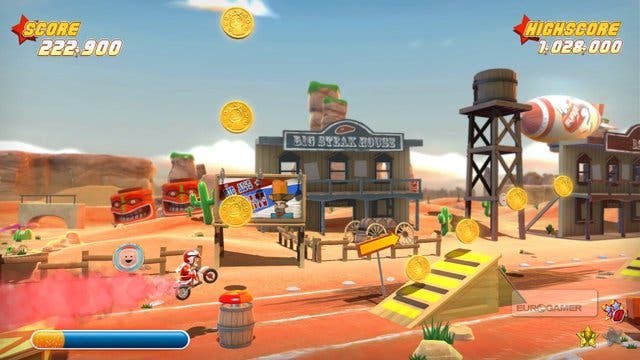Creative Tension
Are publishers impeding the creativity of the medium?
"It was probably all a terrible mistake..."
In 2009, Sean Murray and the rest of the Hello Games team flew to the US to pitch their first title, Joe Danger, to a publisher. It didn't go smoothly.
"Everything had been going great," Murray recalls. "We gave probably the best pitch and demo of Joe Danger we've ever done. The whole room seemed to be loving it, and afterwards we kept talking enthusiastically with the game running on this big screen behind us."
Then an unexpected visitor made an appearance. Murray didn't know, but the previous weekend one of his colleagues had put a snail character into the level. "He's purple, with green spots and crazy eyes and an actual two-storey house on his shell. He's about twice the size of Joe. What you'd normally call surreal."
"So this crazy purple snail suddenly shuffles past on the huge projector behind us, about four-foot tall, his eyes just staring out of the screen. Everyone stops, and you can feel it coming.
"Someone says, 'Is Joe really small or is that snail really big?' Then, 'Actually, how big is Joe Danger, anyway?'"
The Hello Games team hadn't given it much thought. "It's a game, you know?" says Murray. "We've got a talking mole too, and Joe goes around collecting giant floating coins, for f**k's sake." So that's what he told the publishers.
"That was a mistake," he reflects. The meeting then descended into a long debate about the snail:
"I don't think people want to play as a character that's smaller than a coin..."

"If Joe is normal size, then that would be a giant snail, so that could resonate..."
"Giant spinning coins don't seem realistic, though. The snail can stay, but the coins need to go..."
"Maybe he could fight it?"
It didn't end there. The argument dragged on and on, with calls and emails going back and forth for over a month. "I honestly believe this publisher thought we were trying to make a realistic game," says Murray, "and that we were just confused about what size real things are." Eventually, Hello Games decided to go it alone, choosing to release Joe Danger independently. "We did it for that surreal little snail and everything he stood for," says Murray.
Every developer has a story like this. Whether it's over a seemingly innocuous detail like the size of your tubby cartoon protagonist or a more fundamental issue about the direction of the game, developers can often find themselves on the receiving end of some puzzling creative input.

It all comes down to money. Publishers are terrified of alienating even a tiny chunk of their prospective user base. They're conservative businessmen who don't want innovation, experimentation or artistic merit, just cash and a safe return on their investment. And if you can't even put a giant purple snail in your cartoon racing game, what hope do developers have of pushing truly innovative ideas?
That's the argument, anyway. But does it actually stand up? It's undeniable that the industry is awash with sequels and clones, but are the publishers really to blame? Are they impeding the creativity of the medium? And are developers really struggling to find support for new ideas?
The creative relationship between developers and publishers is a subject that Atomic Games president Peter Tamte is eminently qualified to discuss. In April 2009, the FPS he was working on was ditched by Konami after the game's lofty creative ambitions stirred up controversy.
